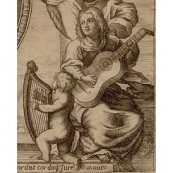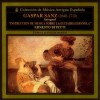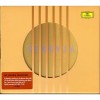Composers
Gaspar Sanz (1640–1710) was an Aragonese composer, guitarist, organist and priest born to a wealthy family in Calanda in the comarca of Bajo Aragón, Spain. He studied music, theology and philosophy at the University of Salamanca, where he was later appointed Professor of Music. He wrote three volumes of pedagogical works for the baroque guitar that form an important part of today's classical guitar repertory and have informed modern scholars in the techniques of baroque guitar playing.
His birth date is unknown but he was baptized as Francisco Bartolome Sanz y Celma in the church of Calanda de Ebro, Aragon on 4 April 1640 later adopting the first name "Gaspar".
After gaining his Bachelor of Theology at the University of Salamanca,[1] Gaspar Sanz travelled to Naples, Rome and perhaps Venice to further his music education. He is thought to have studied under Orazio Benevoli, choirmaster at the Vatican and Cristofaro Caresana, organist at the Royal Chapel of Naples. He spent some years as the organist of the Spanish Viceroy at Naples.
Sanz learned to play guitar while studying under Lelio Colista and was influenced by music of the Italian guitarists Foscarini, Granata, and Corbetta. When Sanz returned to Spain he was appointed instructor of guitar to Don Juan (John of Austria), the illegitimate son of King Philip IV and Maria Calderon, a noted actress of the day.
In 1674 he wrote his now famous Instrucción de Música sobre la Guitarra Española,[2] published in Saragossa and dedicated to Don Juan.[3] A second book entitled Libro Segundo de cifras sobre la guitarra española was printed in Saragossa in 1675. A third book, Libro tercero de mùsica de cifras sobre la guitarra española, was added to the first and second books, and all three were published together under the title of the first book in 1697, eventually being published in eight editions. The ninety works in this masterpiece are his only known contribution to the repertory of the guitar[4] and include compositions in both punteado ("plucked") style and rasqueado ("strummed") style.
In addition to his musical skills, Gaspar Sanz was noted in his day for his literary works as a poet and writer, and was the author of some poems and two books now largely forgotten.
He died in Madrid in 1710.
Biography
Gaspar Sanz (1640–1710) was an Aragonese composer, guitarist, organist and priest born to a wealthy family in Calanda in the comarca of Bajo Aragón, Spain. He studied music, theology and philosophy at the University of Salamanca, where he was later appointed Professor of Music. He wrote three volumes of pedagogical works for the baroque guitar that form an important part of today's classical guitar repertory and have informed modern scholars in the techniques of baroque guitar playing.
His birth date is unknown but he was baptized as Francisco Bartolome Sanz y Celma in the church of Calanda de Ebro, Aragon on 4 April 1640 later adopting the first name "Gaspar".
After gaining his Bachelor of Theology at the University of Salamanca,[1] Gaspar Sanz travelled to Naples, Rome and perhaps Venice to further his music education. He is thought to have studied under Orazio Benevoli, choirmaster at the Vatican and Cristofaro Caresana, organist at the Royal Chapel of Naples. He spent some years as the organist of the Spanish Viceroy at Naples.
Sanz learned to play guitar while studying under Lelio Colista and was influenced by music of the Italian guitarists Foscarini, Granata, and Corbetta. When Sanz returned to Spain he was appointed instructor of guitar to Don Juan (John of Austria), the illegitimate son of King Philip IV and Maria Calderon, a noted actress of the day.
In 1674 he wrote his now famous Instrucción de Música sobre la Guitarra Española,[2] published in Saragossa and dedicated to Don Juan.[3] A second book entitled Libro Segundo de cifras sobre la guitarra española was printed in Saragossa in 1675. A third book, Libro tercero de mùsica de cifras sobre la guitarra española, was added to the first and second books, and all three were published together under the title of the first book in 1697, eventually being published in eight editions. The ninety works in this masterpiece are his only known contribution to the repertory of the guitar[4] and include compositions in both punteado ("plucked") style and rasqueado ("strummed") style.
In addition to his musical skills, Gaspar Sanz was noted in his day for his literary works as a poet and writer, and was the author of some poems and two books now largely forgotten.
He died in Madrid in 1710.




